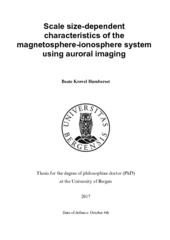| dc.contributor.author | Humberset, Beate Krøvel | |
| dc.date.accessioned | 2017-10-30T14:05:29Z | |
| dc.date.available | 2017-10-30T14:05:29Z | |
| dc.date.issued | 2017-10-06 | |
| dc.identifier.uri | https://hdl.handle.net/1956/16800 | |
| dc.description.abstract | The spectacular and breathtaking aurora dancing around on the night sky visualizes the fundamental behavior of complex processes in the near Earth space. The plethora of papers published over the last five decades have laid the foundation of our understanding of how the Earth’s magnetosphere solves the problem of stored energy and momentum provided by the solar wind. A dominant energy sink in this system is the ionosphere around 100 km above the Earth’s surface where energy and momentum is dissipated with significant implications to the neutral atmosphere. While the magnetosphere-ionosphere system has been shown to be highly dynamic and structured, as visualized by the aurora, most of the observations in space cannot separate between the changes in space and time. Our current understanding of electrodynamic parameters of the magnetosphere-ionosphere system is largely based on simplistic empirical models. The purpose of this thesis is to get beyond the large-scale static picture and advance our understanding of the dynamic magnetosphere-ionosphere system by performing an analysis that allows a separation of spatial gradients and temporal variability and thereby provide new insight into the fascinating Earth-space interactions. To overcome the time-space ambiguity of space observations, we utilize groundbased observations of auroral emissions since they provide extended periods of continuous observations at a fixed position in the ionosphere with high spatial and temporal resolution. The observations are made with an all-sky imager which allows for an analysis of a wide range of auroral scale sizes from microscale to mesoscale auroral scale sizes of a few km to around 250 km. We first utilize these powerful observations to study the often occurring phenomenon of persistent pulsating auroral patches and, secondly, we separate the aurora into different scale sizes and quantify their lifetimes. In Papers I and II [Humberset et al., 2016, 2017a] we provide objective and quantitative characteristics of pulsating auroral patches in order to give better observational constraints on the suggested mechanisms and address some of the questions about fundamental aspects of pulsating aurora. In Paper I we address the underlying mechanism( s) that controls the on-off fluctuations, while Paper II addresses what controls the shape and coherency of pulsating auroral patches. We find that the fluctuating auroral patches display a striking and puzzling variability. The patches do not fluctuate in a coherent fashion, the energy deposition is highly variable from one fluctuation to the next, the on-time varies wildly and does not show any correlation to the preceding off-time, nor the peak intensity. The only parameter which appears to be consistent for pulsating auroral patches, is their shape. The name pulsating aurora is therefore a misnomer, and fluctuating aurora is a more appropriate description of the phenomenon. There are no clear winning candidates of the suggested mechanisms to explain the observational constraints set by the fluctuating auroral patches in a satisfactory manner. Our interpretation of the findings is that the mechanism is located at lower altitudes and not in the plasma sheet. In Paper III [Humberset et al., 2017b] we developed an innovative image analysis combining spatial frequency filtering to separate the images into 2D scale sizes, and a temporal correlation to reveal the time scales of change in the different scale sizes. The analysis was tested on an event of a pre-midnight auroral display during a period of fairly constant moderate geomagnetic disturbances. The resulting characteristics showed a scale size dependent variability where the largest scale sizes are stable on time scales of minutes while the small scale sizes are more variable. The average spatiotemporal characteristics of the auroral emissions are in remarkable agreement with the spatiotemporal characteristics of the nightside Birkeland currents during moderately disturbed times. Thus, two different electrodynamical parameters of the M-I coupling show similar behavior. This result is interpreted as an indication of a system that uses repeatable solutions to transfer energy and momentum from the magnetosphere to the ionosphere. | en_US |
| dc.language.iso | eng | eng |
| dc.publisher | The University of Bergen | en_US |
| dc.relation.haspart | Paper I: Humberset BK, Gjerløv J, Samara M, Michell R, Mann IR. Temporal characteristics and energy deposition of pulsating auroral patches. Journal of Geophysical Research - Space Physics. 2016;121(7):7087-7107. The article is available at: <a href="http://hdl.handle.net/1956/12916" target="blank">http://hdl.handle.net/1956/12916</a> | en_US |
| dc.relation.haspart | Paper II: Humberset BK, Gjerløv J, Mann, IR, Michell R, Samara, R. Do pulsating auroral patches vary in a coherent fashion? Full text not available in BORA. | en_US |
| dc.relation.haspart | Paper III: Humberset BK, Gjerløv J, Samara M, Michell R. Scale size-dependent characteristics of the nightside aurora. Journal of Geophysical Research - Space Physics. 2017;122(2):2455-2466. The article is available at: <a href="http://hdl.handle.net/1956/15717" target="blank">http://hdl.handle.net/1956/15717</a> | en_US |
| dc.title | Scale size-dependent characteristics of the magnetosphere-ionosphere system using auroral imaging | en_US |
| dc.type | Doctoral thesis | |
| dc.rights.holder | Copyright the Author. All rights reserved | en_US |
| dc.identifier.cristin | 1501372 | |
